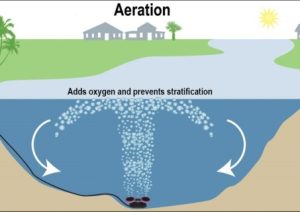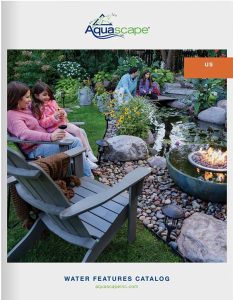Breathe Life into Your Water: Elevate Pond Health with Expert Aeration.
Aeration Central Customer Resources
Pond, Lake & Water Garden Resources
At Aeration Central, we understand that knowledge is key to maintaining a healthy pond or lake ecosystem. Our Resources page is designed to provide you with a comprehensive collection of guides, FAQs, and useful links to empower you with the information you need. From understanding the importance of aeration to best practices for system maintenance, our curated resources will help you optimize your experience. Join us in promoting cleaner, healthier water bodies with the right tools and knowledge at your fingertips!
Most Frequently Asked Questions
What are the benefits of aeration?
Aeration enhances water quality by increasing oxygen levels, which is vital for the health of any body of water. It helps prevent stagnation, reduces algae blooms, and promotes the breakdown of organic matter. Additionally, proper aeration supports a balanced ecosystem, making your pond or lake more vibrant and sustainable.
How do I know if my pond needs aeration?
Signs that your pond may need aeration include stagnant water, excessive algae growth, fish stress or die-offs, foul odors, and murky water. If you notice any of these issues, it may be time to consider an aeration solution to restore balance and improve overall water quality.
How does aeration work?
 Aeration is a vital process for maintaining the health and clarity of ponds and water bodies. It involves the introduction of air into the water, which enhances oxygen levels. This process is essential because oxygen is crucial for aquatic life, including fish, plants, and beneficial bacteria. Aeration helps to break down organic material and promotes a balanced ecosystem by allowing for the efficient circulation of nutrients throughout the water column.
Aeration is a vital process for maintaining the health and clarity of ponds and water bodies. It involves the introduction of air into the water, which enhances oxygen levels. This process is essential because oxygen is crucial for aquatic life, including fish, plants, and beneficial bacteria. Aeration helps to break down organic material and promotes a balanced ecosystem by allowing for the efficient circulation of nutrients throughout the water column.
The mechanism of aeration can be achieved through various methods, including diffused aeration systems and surface aerators. Diffused aeration systems employ air pumps that send air through submerged diffusers at the pond’s bottom, ensuring efficient oxygen distribution. Conversely, surface aerators mix air directly into the water surface, generating an attractive display while enhancing aeration. Both methods help to prevent stagnation and reduce the buildup of harmful gases, promoting a healthier aquatic environment.
Effective aeration not only supports the growth of fish and other aquatic organisms but also minimizes issues like algae blooms and foul odors. By introducing oxygenated water, aeration encourages the growth of beneficial bacteria that aid in decomposing organic waste and maintaining clear water. Overall, aeration is a simple yet effective solution for enhancing water quality, supporting biodiversity, and creating a thriving ecosystem in ponds and lakes.
What types of aeration systems are available?
There are several types of aeration systems, including diffused air systems, surface aerators, and fountain systems. Diffused aeration uses air diffusers placed at the bottom to circulate oxygen throughout the entire body of water, while surface aerators agitate the water’s surface. Fountains provide both aesthetic appeal and aeration. The best choice depends on your specific pond size, depth, and oxygenation needs.
How often should an aeration system be maintained?
What are beneficial bacteria, and why are they important for my pond?
How do beneficial bacteria help control algae growth?
Beneficial bacteria compete with algae for nutrients in the water. By consuming excess nutrients, they limit the availability of resources that algae need to thrive, thus helping to keep algae populations in check.
Can I use beneficial bacteria in conjunction with aeration systems?
Consumer Brochures
Kasco Water Fountain Products
 Aeration Central is a premier authorized reseller of Kasco Fountain Products, offering a diverse range of high-quality water fountain solutions designed to enhance the beauty and health of your aquatic spaces. Explore our Kasco Product Catalog to discover various styles and designs of water fountains that can transform your pond or lake into a stunning focal point. Use the brochure as a valuable resource for ideas and to learn about the types of fountains available to suit your specific needs.
Aeration Central is a premier authorized reseller of Kasco Fountain Products, offering a diverse range of high-quality water fountain solutions designed to enhance the beauty and health of your aquatic spaces. Explore our Kasco Product Catalog to discover various styles and designs of water fountains that can transform your pond or lake into a stunning focal point. Use the brochure as a valuable resource for ideas and to learn about the types of fountains available to suit your specific needs.
Aquascape Pond and Water Garden Aeration, Accessories and Supplies
 Aeration Central exclusively uses Aquascape Pond and Water Garden Aeration products, providing a comprehensive selection of high-quality water garden, accessories, and supplies. Explore Aquascape Product Catalog to discover effective aeration systems and essential components designed to enhance the health and beauty of your water garden. Use the brochure as a valuable resource for ideas and to learn about the various products available to meet your specific pond and water garden needs.
Aeration Central exclusively uses Aquascape Pond and Water Garden Aeration products, providing a comprehensive selection of high-quality water garden, accessories, and supplies. Explore Aquascape Product Catalog to discover effective aeration systems and essential components designed to enhance the health and beauty of your water garden. Use the brochure as a valuable resource for ideas and to learn about the various products available to meet your specific pond and water garden needs.
